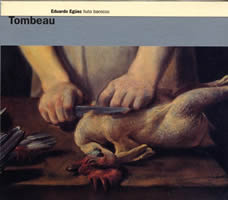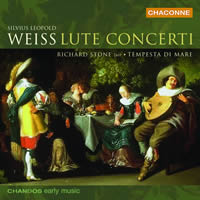The Weiss Resurgence: 3 World Premieres
|
Edward Sandel & Gerardo Tango [July 2005.]
S.L. WEISS: Suite in Sol Maggiore (London mss), Tombeau sur la mort de M. Cajetan Baron D’Hartig, Suite in Do minore (Dresden mss). Eduardo Eguez, Baroque lute (Robert Lundberg). E lucevan le stelle EL-982310 (http://www.elucevanlestelle.com/). Sylvius Leopold Weiss (1687-1746), a contemporary of Bach, Handel and the Scarlattis, is fast becoming known outside lute and Baroque-aficionado circles. Ultimately employed with Fux, Quantz, Pisandel and Zelenka at the Dresden court, Weiss composed over 650 known solo and concerted works for lute that established him among his contemporaries as a master in terms of both quantity and quality. (See http://www.slweiss.com/ for further information.) All three recordings reviewed here involve extensive efforts at authenticity vis-à-vis score and instrument reconstruction, as well as historical recording site selection and efforts at transparent recording technique. Eduardo Eguez’s “Tombeau: Musiche di SL Weiss” on Marco Mencoboni’s specialist label is a rewarding experience, less easily analyzed than taken as a whole. Here Eguez presents two Italianate sonatas and one French-style tombeau. Weiss’ lute partitas differ from Bach’s dance suites after Froberger in characteristically imposing a bourrée between the generally engaging courante and sarabande movements, as yet another example of the late-Baroque goûts réunis. Eguez’s playing, as per his recent Bach and de Visée Baroque lute releases on Todd Garfinkle’s California MA label, exhibits total technical mastery at times slightly hinting at his classical and Spanish guitar backgrounds. On this recording, Eguez employs a 13-course Baroque lute by the late Oregon luthier Robert Lundberg, whose reconstructions and reference book, Historical Lute Construction, have become the choice of many lutenists seeking authentic reproduction of 18th-century lute sound. Eguez’s performance is characterized by acoustical lightness, clarity and delicacy, mixed at times with vigor and surprise, showing considerably more kinds and occurrences of Baroque ornamentations, e.g., in the slower sarabande movements. One often hears a sudden transition in dynamic range, as well as some notes ringing softly, a signature of playing style as well as of the instrument. As played here, the title piece, Tombeau sur la mort de M. Cajetan Baron d’Hartig, barely five minutes long without repeats, is more abbreviated and idiosyncratic than the perhaps better known Tombeau de Comte de Logy, which has over 15 extant recordings. A tombeau is a Baroque funereal-memorial work in 4/4 time, here in E flat major, using the broken-cord style brisé. Although tempo indication is Adagio assai, performance does not adhere strictly to meter, but is played very freely, often slowly with pauses on specific notes. The opening is gently suggestive of low-pitched tolling bells, together with dotted-note rhythms appearing as dotted eighths followed by 16th notes. The devices most clearly heard are ascending and descending four-note motifs. Eguez’s audiophile-quality CD is closely miked in a reverberant environment with high-resolution B&K 4003 omnidirectionals, the experience of which is at times overwhelming. Less than normal playback levels are recommended. Approximate reference recordings would include Konrad Junghänel’s Accent disc (ACC-7780, 1991), which contains the present Tombeau, and more generally Jose Miguel Moreno’s Ars Melancholiae: Weiss CD on Glossa (GCD 2K102, 2000 reissue). As E lucevan le stelle CDs are not yet directly available in the US or via Amazon.com, they are most easily obtained through their chief European distributor at http://www.soundandmusic.com/.
S.L. WEISS: 6 Lute Partitas: Parthia ex D moll, Parthia ex F, Parthia ex A Dur, Parthia ex B, Parthia ex B, Parthia ex D Dur (Warsaw mss). Terrell Stone, Baroque lutes (Robert Lundberg). Mondo Musica MM-96125, 3CDs (http://www.mondo-musica-verlag.de/). Terrell Stone’s interpretations of six Weiss partitas, which he carefully reconstructed at the Conservatorio of the University of Padua in collation of the Warsaw, London and Dresden Weiss manuscripts, manifest a clean and seamless playing of an almost effortless character, in a mature style informed but not frozen by authentic performance practices. Tempos are always correct, leaning more to the reflective than to the kinetic exuberance of younger performers such as Robert Barto (Naxos) and Michel Cardin (SNE), with their eventually tiring “kick-ass” vigor. Although the choice is difficult, the Italian-style courante of Partita No. 1 in D minor (elsewhere designated Sonata No. 11 or Suite 7, according to which Weiss cataloging system is employed) is perhaps the most immediately memorable and best known of the pieces recorded here. A work of triple meter in binary form, about four minutes long with a relentless harmonic drive, its mood is subdued, reflective and gently optimistic (Matheson’s affective “hope and courage”). The opening one-measure harmonic figure repeats to form three-measure groups, used in descending diatonic sequence from tonic to dominant, employing the wonderful terracing effect characteristic of much Baroque instrumental music. Shorter chordal groups of the second part’s sequence cause the harmonic movement to accelerate, arpeggiation of the figure maintaining the feeling of continuous running figures characterizing the Italian-style courante. Terrell Stone’s technique brings out the vibrato, delicacy and cantabile qualities of the Baroque lute, and especially Weiss’ music. This courante was earlier recorded by Hopkinson Smith on Astrée 8620 (1997) and Lutz Kirchhof on Sony S2K 4839 (1986). It was also transcribed for solo flute by Quantz and Buffardin, in what Barthold Kuijken in a recent review in the journal of the German Lute Society has termed a very challenging manner. See his own successful 2001 Accent CD of lute-to-flute transcriptions. Terrell Stone provides an added point of interest in employing two acoustically distinct 13-course Baroque lute reconstructions, also by Robert Lundberg. The first instrument, employed for Partitas 2, 4 and 5, is based on a late-17th-century German original by Johann Hoffmann and is noted for its rich and warm tone but lesser intrinsic volume. The second lute, after Thomas Erdlinger’s Italo-German original, has a faster tonal response and more penetrating and higher-volume sound compared to the Hoffmann instrument. Tuning is in a “low kammerton” with a′ = 390Hz. Lute construction, selection of gut-treble and overwound-midrange and bass strings, along with performance, preserve an excellent balance between bass and treble, producing an untiring clarity of tone not always found in previous lute recordings by others.
S.L. WEISS: 6 Lute Concerti (Dresden mss): Concerto a 5 in C, Concerto in d minor, Concerto for lute and flute in F, Concerto Grosso in B flat, Concerto in F, Concerto for lute and flute in B flat. Richard Stone, Baroque lute (Andrew Rutherford), Gwyn Roberts, transverse flute; Ensemble “Tempesta di Mare.” Chandos CHAN 0707 (http://www.chandos-records.com/). Distributed in the US by Koch Entertainment (http://www.kochint.com/). Following considerable research and reconstruction, issued by ARE Editions in 2004 as Vol. B136 in Recent Researches in Music of the Baroque, and informed by decades of theoretical as well as performance knowledge, Richard Stone and his Tempesta di Mare ensemble have released a remarkable and plausible rendition of how at least six of the Weiss concerti for lute and diverse instruments may have sounded. Stone employs a 13-course gut-stringed lute by Andrew Rutherford after the “Warwick” Frei original, tuned, with the ensemble, at a′ = 415 Hz, which is acoustically different from, but no less satisfying than, the instruments of Terrell Stone and Eduardo Eguez. Despite having to work only from lute parts surviving the 1945 Dresden library fire, almost all the works are vibrant, engaging and joyful in character. Anyone doubting the validity of these reconstructions need only consider the Tempo di Minuetto from the Vivaldi-like Concerto a Cinque in C Major, and especially the lute/flute dialogues of the F major and B flat major Concerti. In the F major Concerto, the first Allegro is taken much in the character of Bachian fugal counterpoint, whereas in the last Allegro, Stone’s lute effectively plays parts that would normally be supplied by an ensemble, providing both harmonies as well as occasional excursions into a masterful solo. In the B flat major Concerto, Stone shows wonderful technique and control of demanding material involving elaborate and rapidly moving parts. Themes are expertly treated, with much imitative counterpoint and greater equality given both instruments. The dialogue between flute and lute is perhaps informed by Stone’s extensive work in Baroque opera performance and production, as well as a long history of both solo and accompanist work. Richard Stone’s lute work is of such a memorable quality, as agile and effortless as it is engaging, that different engineering choices might occasionally have enhanced finer lute detail in the B flat major Concerto, given the advantages of flute and cello in terms of acoustic projection. As with Eduardo Eguez and Terrell Stone’s solo CDs, this recording is, from a production viewpoint, very much a purist’s work, likewise employing minimal post-production processing. As these concerti are world premieres, there are no recordings to compare, though one might point to Hopkinson Smith’s Astrée CD (8643, 1999) of lute concerti by Weiss contemporaries Fasch, Hagen and Kohaut, as well as Michael Troester’s 1979 Thorofon LP of a D minor lute concerto. These Weiss-reviving efforts by Eguez, Terrell and Richard Stone are as enjoyable as they are technically superb. All are exemplary works of scholarship, guided by historically informed instrument reconstruction and performance style, with a correspondingly newer ethos of recording in acoustically live locations that approximate those in which these works were originally heard. The playing is vital, elegant and nuanced. The instrumentalists never allow any piece’s overall sense of movement to decay during the frequent tempo changes and pauses. One aesthetic question, noted by Richard Stone in his Weiss score-reconstruction text, addresses the kinds and degrees of possible falsification by overuse of spot-miking and mixing enhancements in commercial recordings of a lute ensemble as it might be heard in salons or small-hall live performances. And yet these kinds of recording choices seem inescapable and should perhaps be considered as alternative realizations. The many fine qualities of these three recordings help to ensure Weiss’ resurgence, establishing him in a high place among the Baroque’s leading composers. That will almost surely continue, as recordings of new and alternatively reconstructed lute mss. by Weiss, his contemporaries and students come to the fore. * * * Gerardo Tango (Cornell U.) is a semi-retired seismologist and acoustician, currently researching the biography of his late uncle, Maestro Egisto Tango. Edward Sandel (U. of Chicago) is a musician and historian focusing on the Baroque.
[More
SL Weiss]
[Previous Article:
A Requiem Done Right]
[Next Article:
Mostly Symphonies]
|


